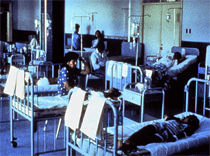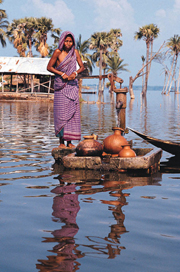Prevention and Control
The risk for cholera is very low for people visiting areas with epidemic cholera. When simple precautions are observed, contracting the disease is unlikely.
All people (visitors or residents) in areas where cholera is occurring or has occurred should be aware of the basic cholera facts and observe five basic cholera prevention recommendations.
What is Cholera Disease?
- Cholera disease causes a lot of watery diarrhea and vomiting
- Cholera diarrhea can look like cloudy rice water
- Cholera can cause death from dehydration (the loss of water and salts from the body) within hours if not treated

A cholera treatment center
How is Cholera Spread?
- Cholera germs are found in the feces (poop) of infected people
- Cholera is spread when feces (poop) from an infected person gets into the water people drink or the food people eat
- Cholera is not likely to spread directly from one person to another
What to do if you think that you or someone in your family has cholera
- If you have oral rehydration solution (ORS), start taking it now; it can save your life
- Go immediately to the nearest health facility. Continue to drink ORS at home and while you travel to get treatment
- Continue to breastfeed your baby if they have watery diarrhea, even when traveling to get treatment
Five Basic Cholera Prevention Messages
- Drink and use safe water*
- Bottled water with unbroken seals and canned/bottled carbonated beverages are safe to drink and use
- Use safe water to brush your teeth, wash and prepare food, and to make ice
- Clean food preparation areas and kitchenware with soap and safe water and let dry completely before reuse
To be sure water is safe to drink and use:- Boil it or treat it with a chlorine product or household bleach
- If boiling, bring your water to a complete boil for at least 1 minute
- To treat your water with chlorine, use one of the locally available treatment products and follow the instructions. For a list of products distributed by country, visit CDC’s Safe Water System website
- If a chlorine treatment product is not available, you can treat your water with household bleach. Add 8 drops of household bleach for every 1 gallon of water (or 2 drops of household bleach for every 1 liter of water) and wait 30 minutes before drinking
- Always store your treated water in a clean, covered container

A woman collecting water
- Wash your hands often with soap and safe water*
- Before you eat or prepare food
- Before feeding your children
- After using the latrine or toilet
- After cleaning your child’s bottom
- After taking care of someone ill with diarrhea
- Use latrines or bury your feces (poop); do not defecate in any body of water
- Use latrines or other sanitation systems, like chemical toilets, to dispose of feces
- Wash hands with soap and safe water after defecating
- Clean latrines and surfaces contaminated with feces using a solution of 1 part household bleach to 9 parts water
- Defecate at least 30 meters away from any body of water and then bury your feces
- Dispose of plastic bags containing feces in latrines, at collection points if available, or bury it in the ground. Do not put plastic bags in chemical toilets
- Dig new latrines or temporary pit toilets at least a half-meter deep and at least 30 meters away from any body of water
- Cook food well (especially seafood), keep it covered, eat it hot, and peel fruits and vegetables*
- Boil it, Cook it, Peel it, or Leave it
- Be sure to cook shellfish (like crabs and crayfish) until they are very hot all the way through
- Clean up safely—in the kitchen and in places where the family bathes and washes clothes
- Wash yourself, your children, diapers, and clothes, 30 meters away from drinking water sources
Vaccines
Currently, there are two oral cholera vaccines available, Dukoral (manufactured by SBL Vaccines) which is World Health Organization (WHO) prequalified and licensed in over 60 countries, and ShanChol (manufactured by Shantha Biotec in India), which is licensed in India and is pending WHO prequalification.
Because the vaccine is a two dose vaccine, multiple weeks can elapse before persons receiving the vaccine are protected. Therefore, vaccination should not replace standard prevention and control measures In addition, CDC does not recommend cholera vaccines for most travelers, nor is the vaccine available in the United States. This is because the available vaccines offer incomplete protection for a relatively short period of time.
Further information about Dukoral can be obtained from the manufacturers:
Dukoral® SBL Vaccin AB,
SE-105 21 Stockholm, Sweden
telephone +46-8-7351000,
e-mail: info@sblvaccines.se
website: www.sblvaccines.se
Contact Us:
- Centers for Disease Control and Prevention
1600 Clifton Rd
Atlanta, GA 30333 - 800-CDC-INFO
(800-232-4636)
TTY: (888) 232-6348
24 Hours/Every Day - cdcinfo@cdc.gov


